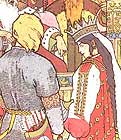


Sixty Folk-Tales From Exclusively Slavonic Sources by A. H. Wratislaw
Return
to
Sixty Folk-Tales
Table of Contents
Bohemian
Stories
Introduction
I.
Long, Broad, and Sharpsight
II.
'The Three Golden Hairs of Grandfather Allknow'
Introduction
to Bohemian Stories
THESE stories are translated from the language of the Slavonic inhabitants of nearly three-fourths of Bohemia, the Czechs, as the Poles write the word, or Chekhs, if we adopt the nearest orthographical approximation to it that the English alphabet allows us to make. This nation had an early literary development, commencing before the foundation of the University of Prague (Praha) by the Emperor Charles IV. in 1348. For a long time after that epoch the Bohemians could justly claim the title of the best educated nation in Europe. They produced a prose writer--Thomas of Stitny, whose first original work was published in 1377--whose equal is not to be found in English literature till the age of Queen Elizabeth. In the Thirty Years' War (1620) the people and literature of Bohemia were crushed for more than two centuries, the population being reduced during that terrible war from over four millions to eight hundred thousand.
The Bohemian language itself is a very remarkable one. It possesses both accent and quantity independent of each other, like Latin and Greek. Thus it is difficult for a foreigner to read aloud or to speak, for, if he attends carefully to the accent, he is liable to neglect quantity, and if he attends to quantity, he is likely to slur over the proper accentuation of words. It, as well as Polish, employs a sibillated r, which in many words is difficult to pronounce. It also writes semi-vowels, especially r, without a vowel; so that many syllables appear as if there were no vowel in them. But this it is sufficient to notice once for all, as it causes no real difficulty in pronunciation.
The fairy-tales relating to the kindly or malevolent superhuman inhabitants of the woods are peculiar and striking. In No. 5 these imaginary beings are represented under the latter, and in No. 6 under the former aspect.
Two waters, one of death and the other of life, are found in the Bohemian stories, just as in the Russian ones--a point wherein the Slavonic tales regularly differ from those of Western Europe, which only acknowledge the water of life. As Mr. Ralston remarks (Songs of the Russian People, p. 97) 'When the "dead water" is applied to the wounds of a corpse, it heals them, but before the dead body can be brought to life, it is necessary to sprinkle it with the "living water."'
The text came from:
Wratislaw, A. H. Sixty Folk-Tales From Exclusively Slavonic Sources. Boston: Houghton, Mifflin, & Company, 1890.

©Heidi
Anne Heiner, SurLaLune Fairy Tales
E-mail: surlalune@aol.com
Page last updated September 18, 2006
www.surlalunefairytales.com



